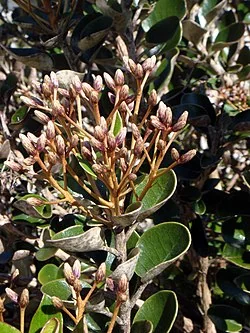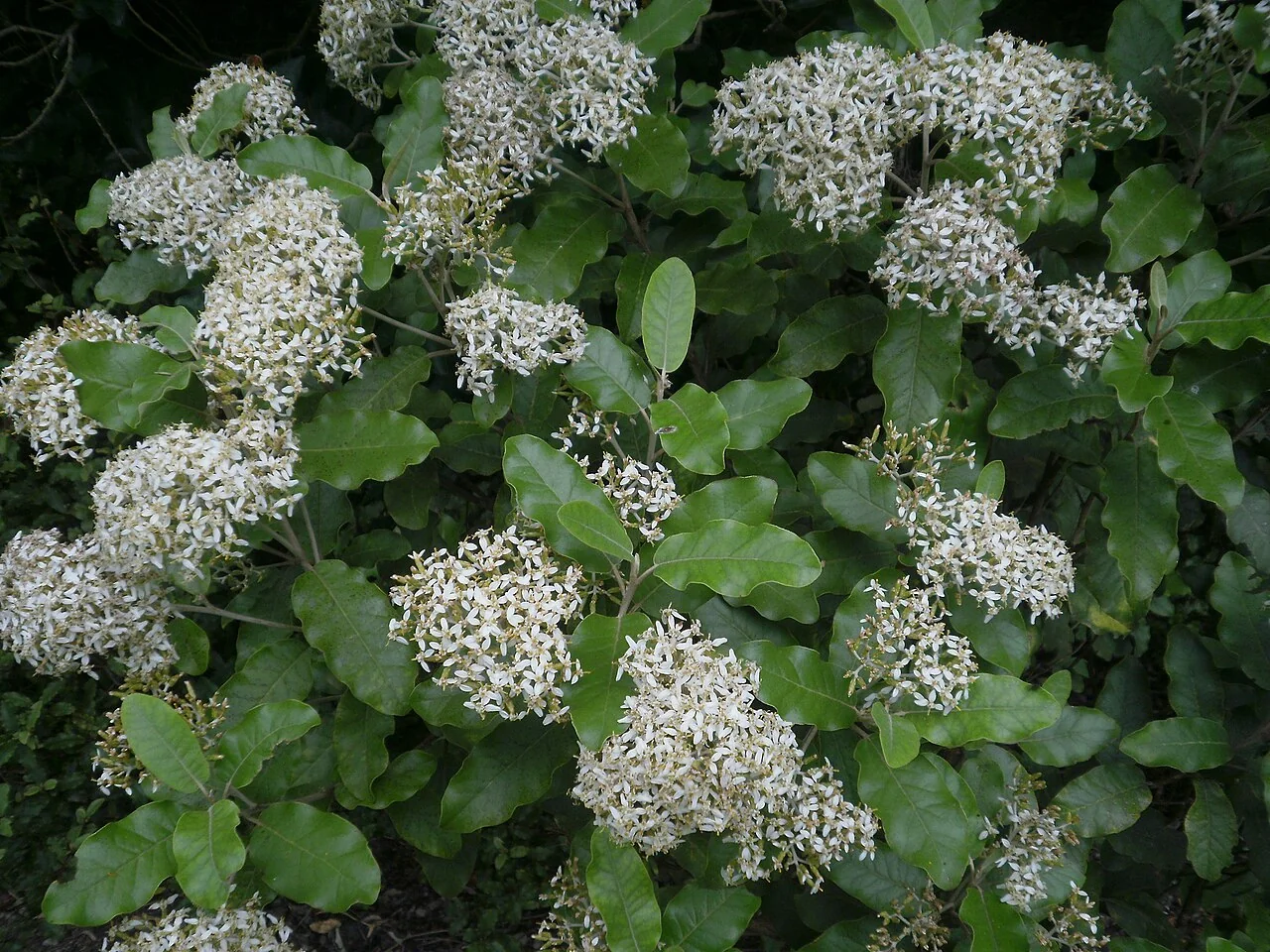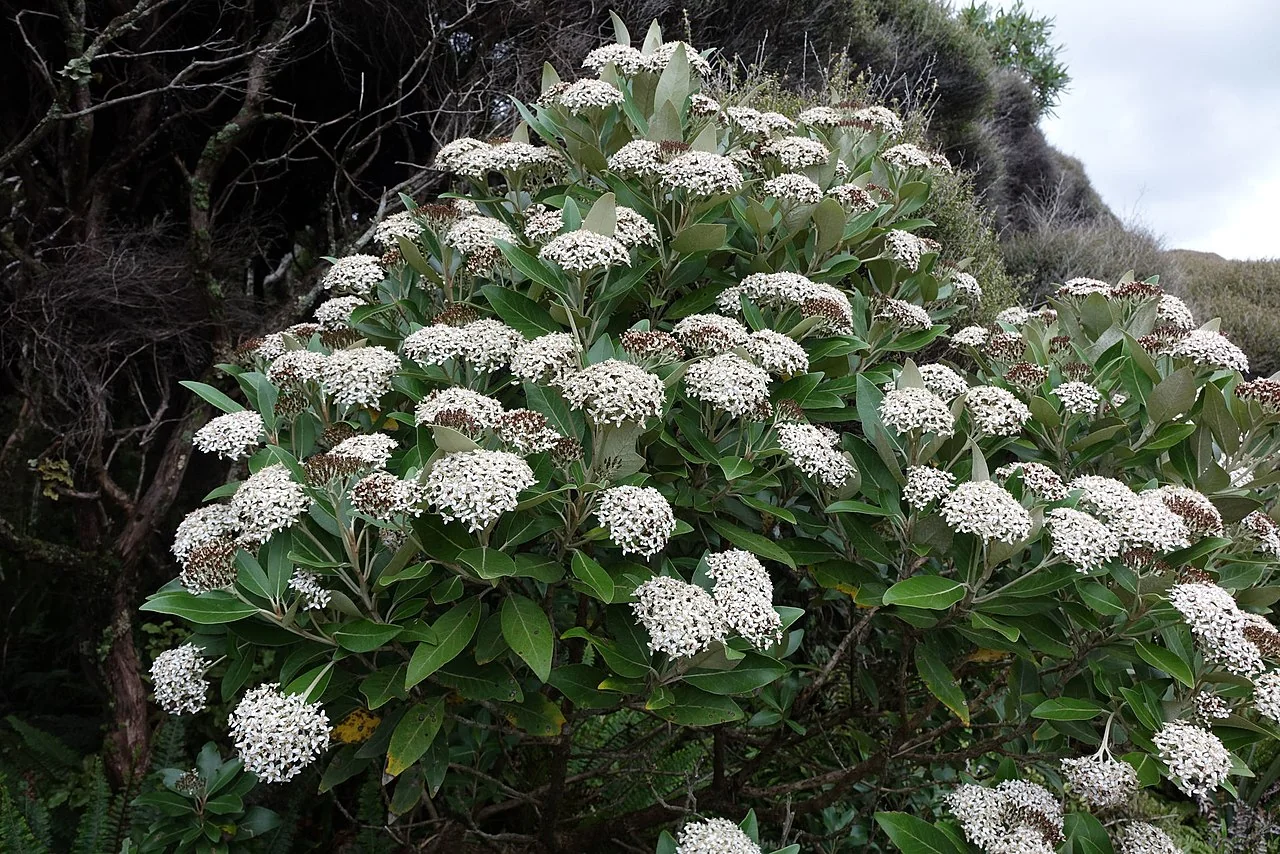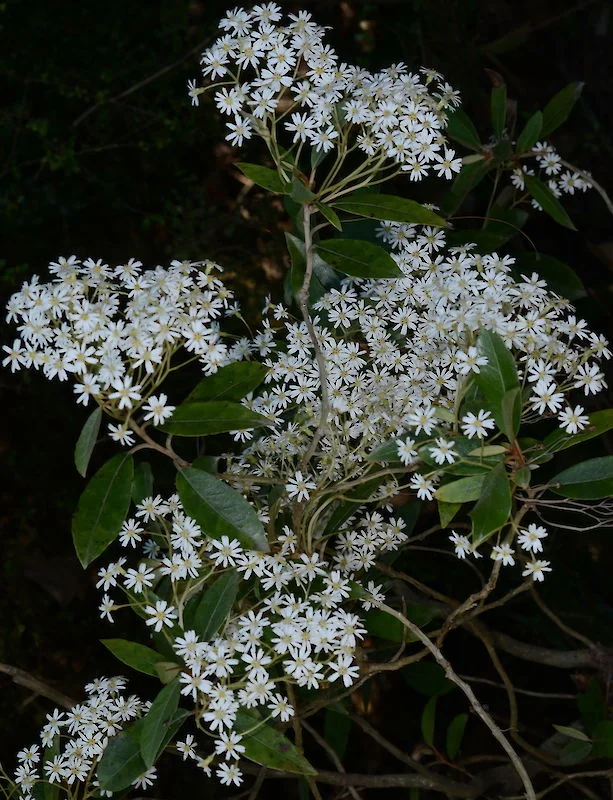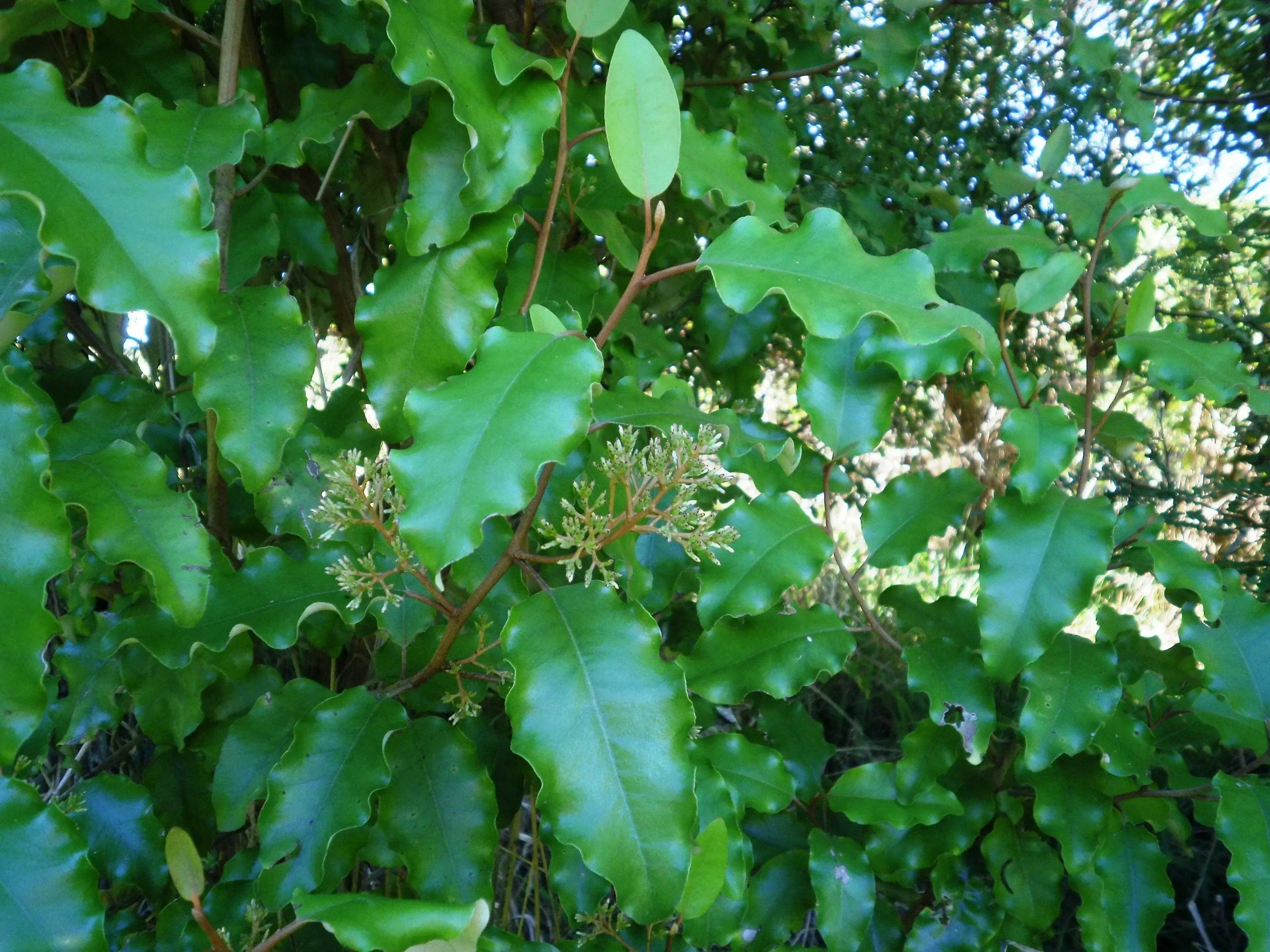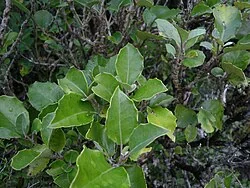
Tree Daisy
Olearia arborescens
Introduction
About Tree Daisy
Olearia arborescens , commonly known as Tree Daisy or Pekapeka, is a robust native shrub or small tree that creates spectacular displays of masses of small white or cream daisy flowers, typically blooming prolifically in late summer and autumn. This hardy member of the Asteraceae family is naturally found in forest margins, scrublands, and coastal areas throughout New Zealand, where it has developed exceptional resilience to wind, drought, and poor soils. Tree Daisy is particularly valued in cultivation for its fast growth, reliable flowering, and exceptional wildlife value, providing crucial late-season nectar when many other plants have finished blooming, while its dense branching structure offers shelter for small birds and beneficial insects throughout the year. Explore more in the native plants index .

Plant Description
Botanical Features
Tree Daisy ( Olearia arborescens ), also known as common tree daisy, glossy tree daisy, or pekapeka, is a native New Zealand shrub or small tree, growing up to 4 meters tall. It has leathery, oval, pointed, and dark green leaves with a glossy upper surface and a paler underside. They typically measure 4-8 cm long and have a few small, sharp bumps along the edge. The leaves are arranged simply and display pinnate venation. It produces large clusters of white, daisy-like flowers from October to January (mid-spring to mid-summer). The flower petals are white, and the centre is pale yellow. Each flower head can have 15-20 individual flowers. The flowers develop into fluffy, wind-dispersed seeds from December to March. The trunk has thin, papery bark that peels in long, thin flakes.
Quick Facts
Overview
| Scientific Name | Olearia Arborescens |
|---|---|
| Height | 2-6 m |
| Spread | 2-4 m |
| Water Needs | Low to moderate |
| Light | Full sun to partial shade |
| Frost Tolerance | Moderate to good |
| Salt Tolerance | Moderate |
| Growth Rate | Moderate |
| Lifespan | Long-lived |
Climate Best Suited to
Regional climate suitability across major New Zealand cities.
Regional Suitability
| Whangārei | Ideal |
| Auckland | Ideal |
| Hamilton | Suitable |
| Rotorua | Suitable |
| Tauranga | Ideal |
| Gisborne | Ideal |
| New Plymouth | Ideal |
| Whanganui | Ideal |
| Palmerston North | Suitable |
| Napier | Ideal |
| Wellington | Ideal |
| Nelson | Ideal |
| Christchurch | Suitable |
| Dunedin | Suitable |
| Invercargill | Suitable |
| City | Climate Suitability |
|---|
Natural Habitat
Tree Daisy is a versatile shrub or small tree found in a variety of habitats throughout New Zealand, from lowland to alpine scrubland. It is particularly common in mountainous areas like the Southern Alps, but can also be found in lowland environments such as beach forests. It prefers areas with high moisture, such as riparian zones, and can tolerate extreme climates, including high winds and short growing seasons.
Plant Conservation
Conservation
Olearia arborescens , also known as the common tree daisy or pekapeka, is a New Zealand native shrub or small tree that is currently classified as "Not Threatened." This conservation status has been consistent since at least 2004. The plant is endemic to New Zealand and can be found in various habitats, including lowland to alpine scrubland across the North, South, and Stewart Islands. It is a hardy species that tolerates a wide range of soil types and conditions, including coastal and exposed environments. Introduced mammals such as deer, possums, and pigs do not pose a significant threat to Olearia arborescens , as it is not considered a primary food source for these animals. Its resilience and adaptability make it a popular choice for revegetation, shelter planting, and native gardens, and it is occasionally sold by specialist native plant nurseries.
Growing Requirements
Soil Requirements
Free-draining loams enriched with organic matter suit Tree Daisy best. Avoid heavy waterlogged clays; tolerates coastal sands with mulch.
Light Requirements
Full sun to partial shade; shelter improves leaf quality in windy sites.
Water Requirements
Low-moderate once established; regular moisture first 1-2 summers.
Planting Guide
1. Site Selection and Soil:
- Sunlight: Plant in full sun or partial shade. While it can tolerate some shade, it blooms best with significant direct sunlight.
- Soil: Olearia arborescens thrives in well-drained soil and can tolerate a wide range of soil types, including poorer and stony soils. Avoid wet soils to prevent root rot. If you have heavy clay soil, improve drainage by adding sand.
- Conditions: It is well-suited to coastal and exposed conditions and has high wind tolerance. It is also frost-hardy.
2. Planting:
- Timing: Plant in autumn or spring to give the roots the best chance of establishing.
- Spacing: When planting in groups, space plants about 3-4 meters apart to allow for their mature spread.
- Mulching: Apply a layer of organic mulch around the base of the plant to conserve soil moisture, suppress weeds, and regulate soil temperature.
Ecological Role
Environmental Benefits
Tree daisy ( Olearia arborescens ) is a light‑demanding shrub or small tree of coastal to montane shrublands and forest margins. Its massed daisy heads provide nectar and pollen to native flies, beetles and solitary bees during summer, while the dense, wind‑firm foliage offers shelter and perching sites for birds along exposed edges and ridgelines.
- Pollinator resource: Showy capitula feed a broad guild of native insects.
- Edge structure: Builds shelter on windy margins, aiding successional planting.
- Disturbance coloniser: Establishes after clearance and maintains cover on poor soils.
Uses and Significance
Produces exceptional displays of abundant daisy flowers that provide vital nectar and pollen resources for native bees, butterflies, hoverflies, and other beneficial pollinators during the crucial late-season period when few other plants are flowering. The dense, twiggy branching structure creates excellent shelter and potential nesting sites for small native birds, while also providing habitat complexity that supports diverse invertebrate communities essential for healthy ecosystem function.
Landscape Uses
Hedging/shelter, coastal gardens, and mixed native borders; clips lightly.
Cultural Significance
Traditional Uses and Values
Olearia arborescens , commonly known as Tree Daisy or Pekapeka, is a common shrub or small tree native to New Zealand. While it is recognized as a unique component of New Zealand's native flora, specific traditional uses or symbolic meanings are not widely documented beyond its Māori name.
Its ecological role in providing shelter and nectar for native wildlife, and its attractive daisy-like flowers, contribute to its natural heritage value.
Landscaping Ideas
Versatile Evergreen Daisy
- Hedging/screening: Responds to light clipping for dense, wind-filtering hedges.
- Mixed borders: Pair with coastal-tough natives for year-round texture and summer bloom.
- Pollinator plant: Massed daisies support beneficial insects.
Full sun with free-draining soils gives best form and flowering. Mulch to conserve moisture in dry summers.
Seasonal Care Calendar
Spring
Tip-prune to encourage bushiness; plant new stock.
Summer
Water new plants in dry spells; deadhead if desired.
Autumn
Shape after flowering; mulch.
Winter
Minimal care; ensure drainage.
Pruning and Maintenance
Techniques and Timing
Light trimming immediately after flowering maintains compact form and encourages dense branching while preventing the plant from becoming leggy or open-centred. Tree Daisy responds well to regular light pruning but avoid hard cuts into old, bare wood as this can reduce flowering potential and overall vigor. Annual shaping helps maintain the desired size and form while promoting fresh growth that produces the best flower displays. Deadheading spent flower clusters can help redirect energy into new growth and potentially extend the blooming period.
How to Grow Tree Daisy
Tree Daisy is a robust native shrub or small tree that creates spectacular displays of masses of small white or cream daisy flowers, typically blooming prolifically in late summer and autumn. This hardy member of the Asteraceae family is naturally found in forest margins, scrublands, and coastal areas throughout New Zealand, where it has adapted to challenging conditions including wind, drought, and poor soils. Tree Daisy is particularly valued in cultivation for its fast growth, reliable flowering, and exceptional wildlife value, providing crucial late-season nectar when many other plants have finished blooming, while its dense branching structure offers shelter for small birds and beneficial insects throughout the year. Understanding its propagation methods is key to successfully growing this delightful species.
From Cuttings
Semi-hardwood cuttings are a reliable and efficient method for propagating Tree Daisy, ensuring that new plants retain the exact characteristics of the parent. Take 8-12 cm cuttings from healthy, non-flowering shoots in late summer from current season's growth. Remove lower leaves and treat cut ends with rooting hormone before placing in a well-draining propagation mix. Maintain consistent humidity with misting or enclosed propagation chambers. Successful rooting typically occurs within 4-6 weeks under warm, humid conditions. Once rooted, the new plants can be potted on and grown in a sheltered environment until they are ready for planting.
From Seed
Propagating Tree Daisy from seed is a viable method, though it requires fresh seeds and careful attention to conditions. Collect fine seed from dried flower heads in late autumn, storing in cool, dry conditions until sowing in spring. Surface-sow without covering on a free-draining seed mix, as seed requires exposure to light for optimal germination. Maintain consistent moisture without waterlogging, with germination typically occurring within 2-4 weeks under suitable conditions of 18-20°C. Seedlings develop quickly and transplant readily when large enough to handle safely. This method is crucial for maintaining genetic diversity and for large-scale restoration projects.
Pests and Diseases
Generally Hardy
- Aphids/scale: Manage with oils/soaps; prune congested growth to improve airflow.
- Leaf spot/mildew: Avoid overhead watering; remove affected foliage.
- Waterlogging: Leads to root stress; plant on raised beds in heavy soils.
Bonus Tip
Expert Growing Advice
Tree daisy ( Olearia arborescens ) flowers best in full sun with lean soils. Avoid rich nitrogen feeds; instead, apply a light compost mulch in spring. If using as a hedge, trim immediately after flowering to preserve next season-s buds and keep the screen dense.

